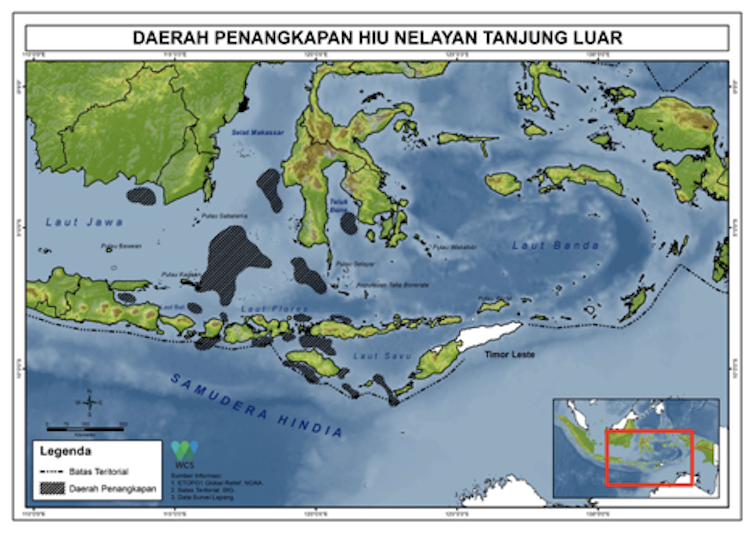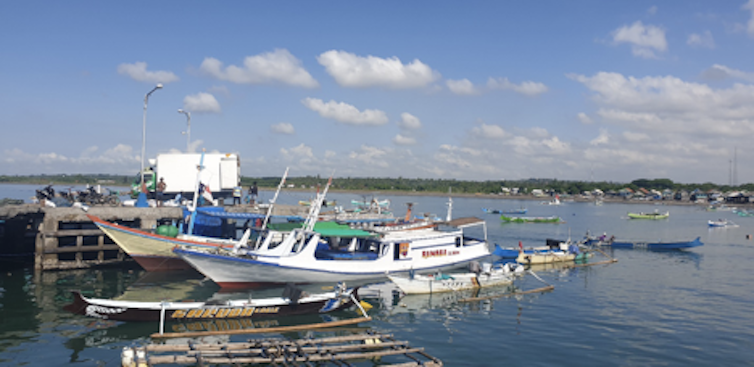Indonesia is home to 117 shark species.
The 2015 report from the Food and Agriculture Agency, FAO, ranked Indonesia in first place among 40 nations that still fish for sharks. In the last decade, Indonesia contributed to more than 10% of the world’s shark catches.
Increasing demand for shark fins, bones, oil and meat in the global market have driven local fishermen to hunt sharks despite their status as endangered species.
Shark fishing is still allowed in Indonesia. Indonesian law only fully protects the whale shark (Rhyncodon typus).
While a ministerial regulation still allows fishing for four shark species – oceanic whitetip shark (Carcharhinus longimanus) and three hammerheads (Spyhrna lewini, Sphyrna zygaena, dan Sphyrna mokarran), to supply only for local market, but ban for export. The export ban had expired in December 2018.
Eight other shark species listed under the Convention on International Trade in Endangered Species of Wild Fauna and Flora (CITES), an international agreement among nations to ensure wildlife trading does not threaten the survival of plants and animals, can still be exported from Indonesia but under strict regulations.
Existing regulations have yet to succeed to maintain sharks population. Hence, declining population and further damage to ocean ecosystems.
Shark is top predator, which reduces the impacts of medium-sized predatory fish, like snapper, grouper and smaller sharks, that consume smaller fish, like parrotfish. The parrotfish are crucial species to protect coral reefs, which are a vital source of life for marine ecosystems.
Uncontrollable declines in shark population will not only affect ocean life, but also humans as they may lose their source of protein.
My research offers the solution to manage shark fisheries without threatening their existence in nature.
Shark fisheries as livelihood
Shark fisheries in Indonesia are comprised of two activities, by-catch and targeted shark fisheries . In the first practice, sharks are caught as a by-catch of fishing for other species. In the second one, the fishermen target sharks from the start.
The targeted shark fisheries relies heavily on a sustainable shark population.
One example is fishers in Tanjung Luar and Maringkik Island of East Lombok, West Nusa Tenggara.

Author provided
Both villages have at least 45-50 boats belonged to fishers’ bosses. These boats are roughly the same size, less than 14 metres with a capacity of 10 gross tons. Around 135 families are involved in the shark fisheries business. Their roles range from being processors and cutters to collectors and sellers.
Local fishers from both villagers usually fish in eastern Lombok to the southern and eastern waters of Kalimantan or Makassar Strait (located between Kalimantan and Sulawesi), Bone Bay of Sulawesi island, and south of Sumba island, close to Australia’s border.
They fish for sharks all year long, regardless of seasons.

Benaya Simeon/WCS, Author provided
If they cannot catch any sharks in their favourite locations, for instance due to bad weather, they look for sharks in other areas, such as Alas Strait or southern Lombok waters, Flores sea of Flores island and Makassar Strait.
This shows fishers in both villages are highly dependent on sharks. Any changes in shark fisheries will affect their social conditions.
Other shark fisheries are in Cilacap of Central Java and Benoa harbour of Bali. These are categorised as by-catch fisheries.
However, unlike in East Lombok, they operate in large vessels (60 GT) and their main targets are large pelagic fishes, such as tuna, swordfish (Xiphias gladius) and mackerel.
Sharks caught in the nets are still cut for their fins. The fishers throw the rest of the carcasses back into the water.
As demands for shark meat in local or domestic markets and exports to developing nations are increasing, the species is becoming an alternative source of protein at an affordable price.
The importance of regulation for shark fisheries
Uncontrolled shark overfishing will have long-term impacts. The recovery of shark populations is very slow due to their low reproduction rates.
Sharks can only reproduce two years after reaching adult age, with a range of 1-40 pups. Sharks reach adult age when they are around 30 years old.
Declining shark populations will affect human food chains. If sharks as the main predators are missing, middle-sized predators will dominate. They will consume smaller fishes that are important food sources for human.
Hence, it is important to regulate shark fisheries to protect the population.
Our study of sustainable shark fisheries in 2018 shows the importance of having spatial and fishing regulation to protect shark populations.
Spatial regulation is an effort to protect important habitats for sharks, such as nursery grounds, as conservation areas.
The regulation may also include closure or seasonal closure regulations in shark catch areas to prevent overfishing, especially in areas abundant with sharks.
Fishing regulation focuses on fishing practices. It regulates the numbers of vessels allowed to catch sharks, number of days in a year each vessel may fish, and types as well as numbers of devices for fishing.
Importantly, the Indonesian government needs to declare shark species as species with a high vulnerability to going extinct. It must fully protect these species and ban shark fishing.
Indonesia already has an action plan to protect sharks and manta rays up to 2020. However, it is still voluntarily without legal basis for enforcement. This is why, it needs strong regulations from the government to protect sharks.



 Bitcoin Reserves Hit 5-Year Low as $2.15B Exits Exchanges – Bulls Quietly Loading the Spring Below $100K
Bitcoin Reserves Hit 5-Year Low as $2.15B Exits Exchanges – Bulls Quietly Loading the Spring Below $100K  An unexpected anomaly was found in the Pacific Ocean – and it could be a global time marker
An unexpected anomaly was found in the Pacific Ocean – and it could be a global time marker  U.S. Black Friday Online Spending Surges to $8.6 Billion, Boosted by Mobile Shoppers
U.S. Black Friday Online Spending Surges to $8.6 Billion, Boosted by Mobile Shoppers  How is Antarctica melting, exactly? Crucial details are beginning to come into focus
How is Antarctica melting, exactly? Crucial details are beginning to come into focus  Rise of the Zombie Bugs takes readers on a jaw-dropping tour of the parasite world
Rise of the Zombie Bugs takes readers on a jaw-dropping tour of the parasite world  Ethereum Ignites: Fusaka Upgrade Unleashes 9× Scalability as ETH Holds Strong Above $3,100 – Bull Run Reloaded
Ethereum Ignites: Fusaka Upgrade Unleashes 9× Scalability as ETH Holds Strong Above $3,100 – Bull Run Reloaded  How America courted increasingly destructive wildfires − and what that means for protecting homes today
How America courted increasingly destructive wildfires − and what that means for protecting homes today  How ongoing deforestation is rooted in colonialism and its management practices
How ongoing deforestation is rooted in colonialism and its management practices  Thousands of satellites are due to burn up in the atmosphere every year – damaging the ozone layer and changing the climate
Thousands of satellites are due to burn up in the atmosphere every year – damaging the ozone layer and changing the climate 































